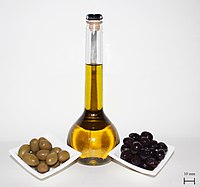
Photo from wikipedia
In this preliminary study, ultra-high-pressure liquid chromatography (UHPLC) coupled to quadrupole-time-of-flight mass spectrometry (QTOF) metabolomics followed by multivariate statistics was applied to discriminate nine extra-virgin olive oil (EVOO) cultivars according… Click to show full abstract
In this preliminary study, ultra-high-pressure liquid chromatography (UHPLC) coupled to quadrupole-time-of-flight mass spectrometry (QTOF) metabolomics followed by multivariate statistics was applied to discriminate nine extra-virgin olive oil (EVOO) cultivars according to their phenolic and sterolic fingerprints. The same approach was then used to discriminate EVOO samples from different geographical origins, namely six blends representative of the main growing regions in Italy (i.e., Sicily, Puglia, Umbria, Liguria, Lombardy and Tuscany). This approach allowed to putatively identify >1000 compounds, considering both polyphenols and sterols. The unsupervised hierarchical cluster analysis (HCA) and the orthogonal projections to latent structures discriminant analysis (OPLS-DA) discriminated EVOO samples according to both cultivar and geographical origin. In particular, flavonoids (i.e., anthocyanins and flavonols), hydroxycinnamic acids and cholesterol derivatives were found to be the most representative classes of compounds discriminating EVOO samples according to the two parameters (cultivar or geographical origin) selected. However, the following Venn analysis allowed to point out the discriminant markers being exclusive for cultivar or origin discrimination. In this regard, only the 9.6% of phenolics and 13.6% of sterols were in common, thus indicating that several of these discriminant compounds were exclusive of a single condition. Indeed, considering that most of the commercial EVOOs are blended, the contribution of both the cultivars used and the geographical origin must be taken into account.
Journal Title: Food research international
Year Published: 2019
Link to full text (if available)
Share on Social Media: Sign Up to like & get
recommendations!